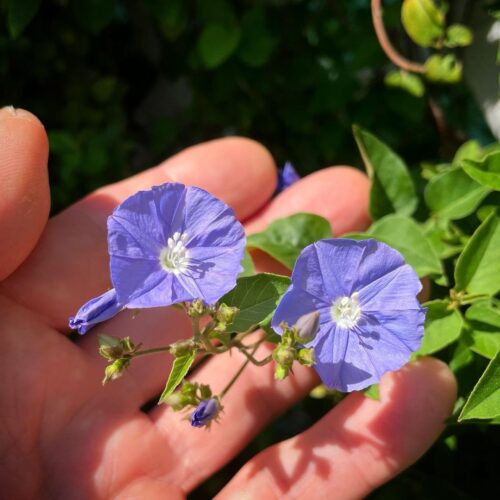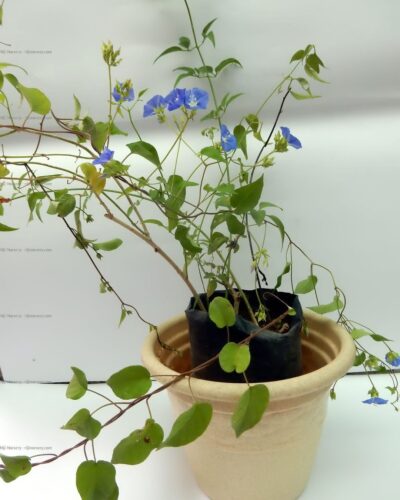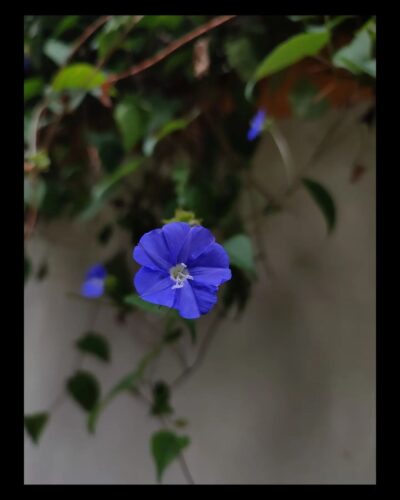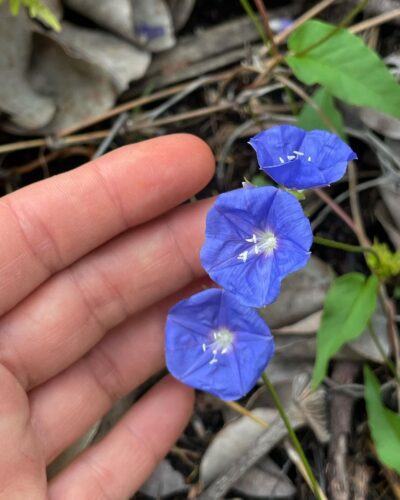Follow this comprehensive Jacquemontia Pentanthos Growing and Care Guide for expert tips to help you nurture this beautiful plant easily.
Give a look at this Jacquemontia Pentanthos Growing and Care Guide for easy tips and fill your garden with pretty blue blossoms.
Common Names: Skyblue Clustervine, Blue Clustervine, Key West Morning-Glory, Jacquemontia canescens, Pineland Clustervine
USDA Zones: 10-11
READ Passiflora Caerulea Growing Guide
Jacquemontia Pentanthos Profile

Jacquemontia Pentanthos, commonly known as “Skyblue Clustervine,” is an evergreen vine from the Convolvulaceae family. This climber is characterized by twining stems and elongated leaves, measuring 1-3 inches (2-7 cm) in length, with prominent veins. It produces an abundance of funnel-shaped flowers in sky blue to pink-lavender hues, featuring white throats. These flowers emerge either individually or in clusters from the leaf axils. Similar to other morning glory family members, the blooms unfurl in the morning and close after nightfall. They serve as a food source for various pollinators.
Skyblue Clustervine is indigenous to regions including South Florida, the West Indies, Mexico, Central America, and South America. In South Florida, it can be found naturally in coastal hammocks and wetland areas. This versatile plant can be trained to grow up trellises or other support structures, or it can be used as groundcover.
Notably, Skyblue Clustervine is classified as an Endangered species by the State of Florida due to its vulnerable status. It is primarily cultivated for its eye-catching flowers, which add ornamental value to landscapes.
Check Blue Tulip Meaning and Varieties
How to Propagate Jacquemontia Pentanthos

Methods to propagate Jacquemontia Pentanthos (Skyblue Clustervine) include:
- Seeds
- Cuttings
- Layering
Propagation from Cuttings:
- Choose a healthy, mature plant for cuttings. Look for stems that are green, disease-free, and have several sets of leaves.
- Cut a 4-6 inch (10-15 cm) section of a stem just below a leaf node. A leaf node is where a leaf grows from the stem. You can take multiple cuttings if desired.
- Remove the leaves from the lower one-third to half of each cutting. This will create a bare stem you’ll plant in the growing medium.
- Plant the cuttings in a well-draining potting mix or a mixture of perlite and peat moss. Insert them about 2 inches (5 cm) deep into the soil or medium.
- Water the cuttings thoroughly after planting to settle the soil and provide moisture. Ensure the soil stays consistently moist but not waterlogged.
- To create a humid environment, cover the cuttings with a plastic bag or place them in a propagation tray with a clear lid. This helps retain moisture and encourages root development.
- Place the cuttings in a location with bright, indirect light. Avoid direct sunlight, which can scorch the delicate cuttings.
- Check the cuttings regularly for signs of roots, which may take several weeks.
- Before planting outdoors, gradually acclimate the new plants to outdoor conditions by exposing them to increasing amounts of sunlight and reducing humidity.
Propagation from Seeds:
- Begin by collecting mature seeds from the existing Skyblue Clustervine plant. Wait until the seed pods have dried and turned brown. Harvest the seeds by gently opening the pods and collecting them.
- After collecting the seeds, it’s a good practice to scarify them lightly. This means gently nicking or scratching the seed coat with a file or sandpaper. This helps water penetrate the seed coat more easily, promoting germination.
- Prepare a well-draining potting mix. You can use a mix of potting soil and perlite or sand to ensure good drainage. Fill small pots or seed trays with this mix.
- Sow the scarified seeds on the surface of the potting mix. Press them lightly into the soil, but do not bury them too deeply.
- Water the seeds gently to settle them into the soil. Keep the soil consistently moist but not waterlogged.
- Optionally, you can cover the pots or trays with a clear plastic lid or wrap to create a mini-greenhouse effect. This helps maintain a humid environment for seed germination.
- Place the pots or trays in a warm location with indirect sunlight. Germination typically occurs within a few weeks to a couple of months, depending on conditions. Keep an eye on the pots and ensure the soil remains moist during this period.
- Once the seedlings have grown large enough and have developed a few true leaves, they can be transplanted into larger pots or directly into the garden if the weather is suitable.
CHECK Texas Star Hibiscus Growing Information
Pot Size for Growing Jacquemontia Pentanthos
For Jacquemontia pentanthos (Skyblue Clustervine), an ideal pot size is approximately 8 to 10 inches (20 to 25 cm) in diameter. Use a lightweight plastic or terracotta pot with good drainage holes to prevent waterlogging. Ensure the pot has a well-draining potting mix, allowing excess water to escape and promoting healthy root growth.
Find Best Tips to Force Aloe Vera to Bloom
Ideal Growing Conditions for Jacquemontia Pentanthos

Light / Location
Jacquemontia Pentanthos, or Sky Blue Clustervine, prefers full sun to partial shade. To maximize sun exposure, plant it in a location where it receives at least 6 hours of sunlight each day, ideally facing south or west. This will help it thrive and produce its beautiful blue flowers.
Soil
Sky Blue Clustervine prefers well-draining soil. Mix garden soil with sand in a 1:1 ratio to improve drainage. The pH level should be slightly acidic to neutral, around 6.0 to 7.0. Avoid heavy clay soils. This soil blend will support healthy growth for your plant.
Water
You must water Jacquemontia Pentanthos consistently, but allow the soil to dry slightly between waterings. Water at the base of the plant in the morning to prevent fungal issues. In hot weather, provide deep watering every 7-10 days, and reduce in cooler seasons to avoid overwatering.
Temperature and Humidity
Jacquemontia Pentanthos thrives in temperatures between 65°F to 85°F (18°C to 30°C). It prefers moderate humidity levels, around 40-60%. Protect it from frost and extreme cold, as it’s sensitive to low temperatures. Providing these conditions will ensure the best growth for your plant.
Explore Ylang-Ylang Tree Growing and Care Guide
Jacquemontia Pentanthos Care

Fertilizer
Feed Sky Blue Clustervine from a balanced, all-purpose fertilizer with an NPK ratio of 10-10-10 or 14-14-14. Apply it every 6-8 weeks during the active growing season (spring and summer). Avoid fertilizing during dormancy (fall and winter) to allow the plant to rest.
Pruning
Trim it in early spring to remove dead or damaged branches and encourage bushier growth. Use clean, sharp pruners and cut just above a leaf node. Lightly shape the plant as needed, but avoid heavy pruning, as it blooms on new growth.
Overwintering
To overwinter Jacquemontia Pentanthos, protect it from freezing temperatures. Before winter, reduce watering to allow it to enter dormancy naturally. Prune lightly to remove dead growth. In colder regions, consider bringing it indoors or covering it with frost cloth to shield it from frost.
Pests and Diseases
Pests:
- Aphids: These tiny insects can cluster on the plant, sucking sap and causing distorted growth. Use a strong spray of water or insecticidal soap to control them.
- Whiteflies: Whiteflies are small, flying insects that feed on plant juices. They can be controlled with insecticidal soap or neem oil.
Diseases:
- Powdery Mildew: This fungal disease appears as a white, powdery substance on leaves. Improve air circulation and avoid overhead watering to prevent it. Fungicidal sprays can help in severe cases.
- Root Rot: Excessive moisture in poorly draining soil can lead to root rot. Ensure well-draining soil and moderate watering to prevent this issue.
- Leaf Spot: Leaf spot diseases cause brown or black spots on leaves. Remove and destroy affected leaves and consider a copper-based fungicide.
Regular inspection, good cultural practices, and maintaining a healthy growing environment will help prevent and manage these issues effectively for Jacquemontia Pentanthos.
Read the Star of Bethlehem Flower Care Tips
FAQs

1. What is Jacquemontia Pentanthos, and how do I identify it?
Jacquemontia Pentanthos, also known as Sky Blue Clustervine, is a beautiful climbing vine with sky-blue flowers. It’s recognized by its trailing or climbing habit and distinctive blossoms.
2. Can I grow Jacquemontia Pentanthos in containers?
Yes, you can grow it in containers, provided they have good drainage. Use a well-draining potting mix and provide a trellis or support for climbing.
3. How long does it take for Jacquemontia Pentanthos to start flowering?
Typically, it begins flowering in its second year once it’s established. Be patient, as its stunning blue blooms are worth the wait.
4. Is Jacquemontia Pentanthos invasive?
While it can be vigorous, it’s not typically considered invasive. However, monitor its growth and prune as needed to prevent it from spreading too aggressively.



